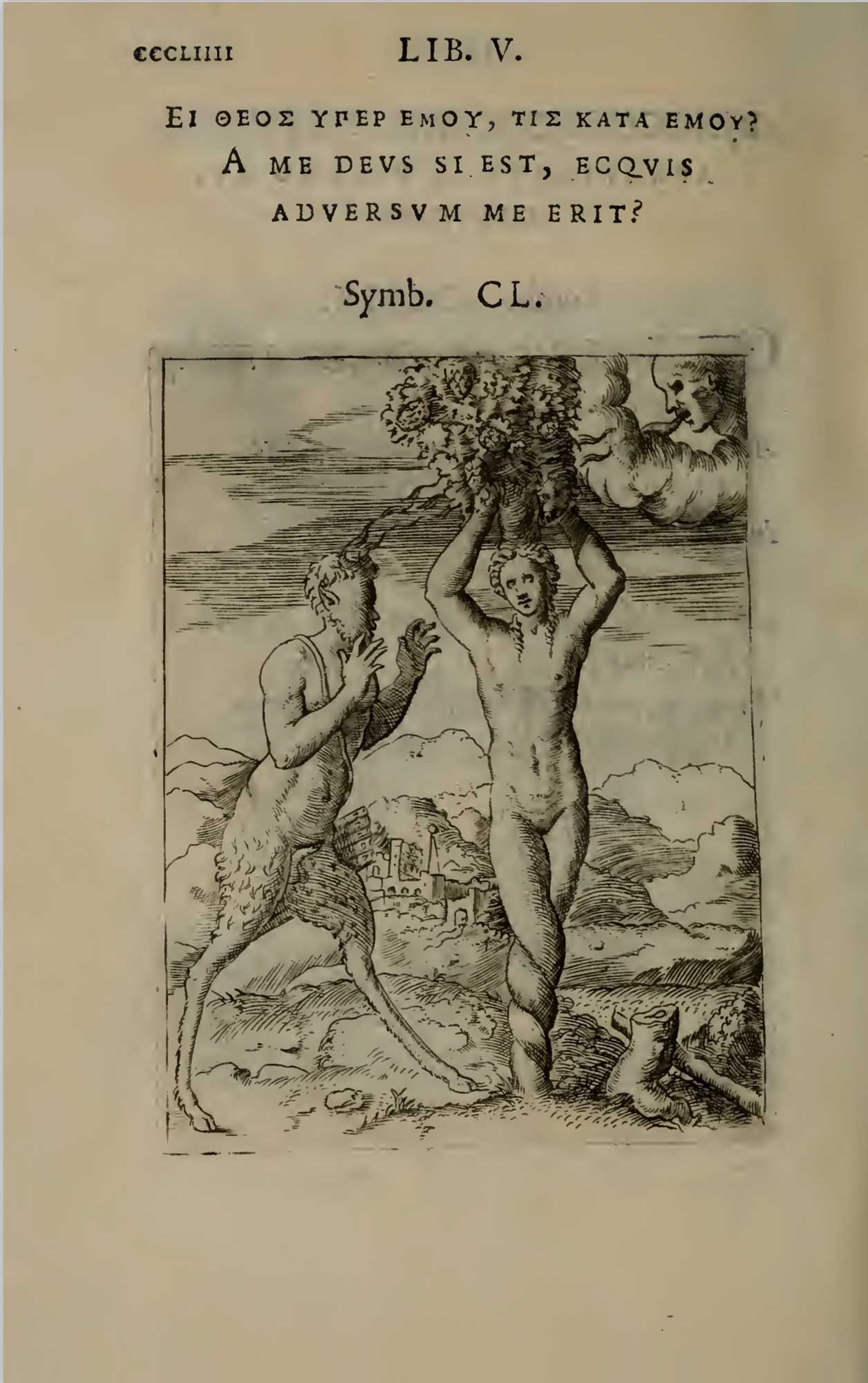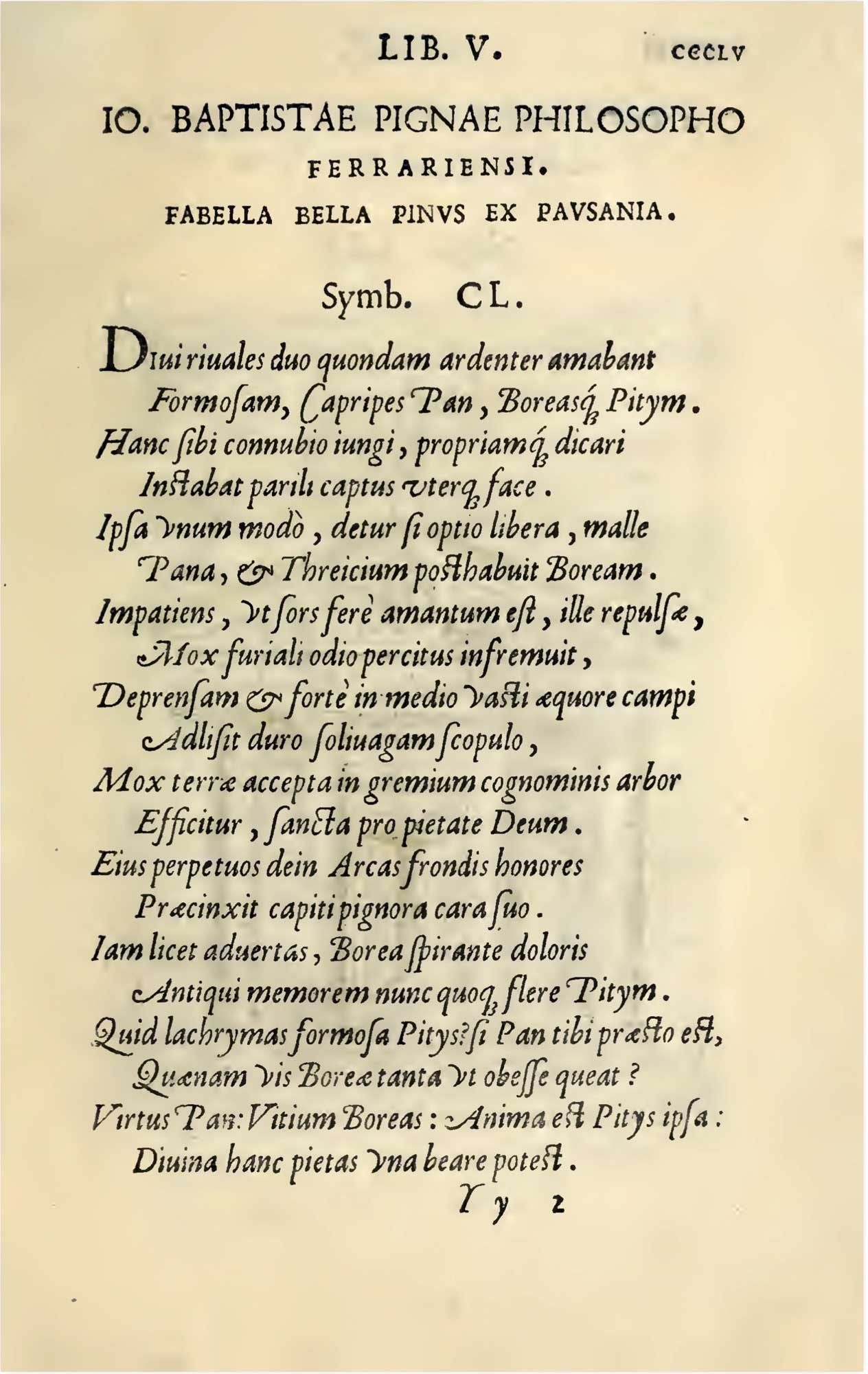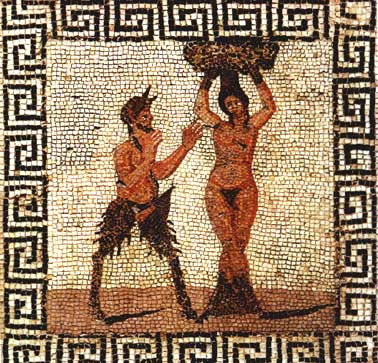Among plants named by metamorphosis of men or women.
In the lore of ancient Greece, Pitys was a nymph. Pitys is mentioned in Longus’ Daphnis and Chloe (ii.7 and 39) and by Lucian of Samosata[1]. Pitys is remembered for her pursuit by Pan, the god of nature and, the folks say, the source of panic. According to a passage in Nonnus’ Dionysiaca (ii.108) she was changed into a pine tree by the gods in order to escape him[2].
1. Lucian (c. AD 125-after 180), Dialogues of the Gods. Thomas Francklin, translator. London: T. Cadell, 1780. 22: Pan and Hermes. Google Books
2. Wikipedia. Wikipedia
Notes
Pan et Pitys

Pan discovering Pitys changed by Boreas into a pine tree
Pitys

10. Baptistae pignae philosopho ferrariensi. Fabella bella pinvs ex pavsania
Pan and the nymph Pitys

Il quadretto di Pan e la ninfa Pitys (oppure di Pan e Hamadryade) è un mosaico falso settecentesco (cm 25 x 27), proveniente dalla Collezione napoletana del Duca Carafa di Noja. Si trova attualmente a Napoli nel Museo Archeologico Nazionale (inv. 27708), associato al Gabinetto Segreto. Che si tratti di un falso che non può provenire da una delle antiche città vesuviane lo attesta un’ incisione di Giulio Bonasone (1510-1574) che lo ritrae seppure con qualche semplificazione, e che è conservata al British Museum.
pine
coniferous tree, Old English pin (in compounds), from Old French pin and directly from Latin pinus “pine, pine-tree, fir-tree,” perhaps in reference to the sap or pitch, from PIE *peie– “to be fat, swell” . Compare Sanskrit pituh “juice, sap, resin,” pitudaruh “pine tree,” Greek pitys “pine tree.”
pine (v.)
Old English pinian “to torture, torment, afflict, cause to suffer,” from *pine “pain, torture, punishment,” possibly ultimately from Latin poena “punishment, penalty,” from Greek poine. A Latin word borrowed into Germanic with Christianity. Intransitive sense of “to languish, waste away,” the main modern meaning, is first recorded early 14c.
Pitys
Hermes: Tell me, are you married yet, Pan? Pan’s the name they give you, isn’t it?
Pan: Of course not, daddy. I’m romantically inclined, and wouldn’t like to have to confine my attentions to just one.
Hermes: No doubt, then, you try your luck with the nanny-goats?
Pan: A fine jest coming from you! My lady-friends are Echo and Pitys and all the Maenads of Dionysus, and I’m in great demand with them.
pitys
C’est le nom grec du pin.
Pitys (stone-pine), from Pitys
Lucian, Dial. Deor. 22.
pytis
vos eritis testes, si quos habet arbor amores,
fagus et Arcadio pinus arnica deo
Ye shall be my witnesses, if trees know aught of love,
beech-tree and pine, beloved of Arcady’s god.
Pytis
Pitys, jeune fille poursuivie de Pan et Borée, ayant manifestée quelque inclination pour ce dernier, fut assommée par Pan contre un rocher. La Tere eut compassion de la victime et la changea en Pin. On plaçait sur les bustes de Pan des couronnes de pin. (Lucien, Dial. des deux, XX11.)
Πίτνζ est d’après le Dictionnaire de Planche, le pin ou picéa. D’apres Belon (De arb. conif., f° 16 r° et v°), le picéa est le πενχη des Grecs, et le pinus le πίτνζ. Or, le picea de Belon nous paraît se rapporter soit au pin de Macédoine (Pinus pence, Grisebach) soit aux diverses varietés du Pinus sylvestris, L.; le pinus de Belon, au Pinus pinea, L., ou pin pignon, Mais les opinions botaniques de Rabelais n’étaient peut-être pas les mêmes de Belon, et la confusion est telle, dans la nomenclature ancienne des Conifères, qu’il est difficile de déterminer exactement l’acception, d’ailleurs variable, de ces vieux vocables. (Paul Delaunay)
pitys
thus pitys, or pine, after the maiden of that name who, preferring Boreas to Pan, was dashed against the rocks by the latter, and transmorgified into a tree by the compassionate gods…
pitys
Pitys, Pin. Elle fut changée en arbre par Pan (d’ou le Pinua amata arcadio deo de Properce (I. 18. 29).
Pytis
Jeune fille poursuivie par Pan et Borée, précipitée du haut d’un rocher et transformée en pin par la terre.
par Metamorphose d’hommes et femmes…
Dans son Officina, Ravisius Textor dresse une longue liste des «Mutati in varias formas» ou l’on trouve Daphné, Narcisse, Crocus (safran) et Smilax. L’origine attribuee au myrte est rapportée par les commentateurs de Dioscoride; celle de pitys (le pin), par Lucien, Dial. des dieux, 22,4, et par les Géoponiques, mais aussi par Cœlius Rhodingus, Antiquae Lectiones, XXV, 2. Celle de cinara (l’artichaut) est dans le livre d’Estienne.
Pitys
In Greek mythology— or more particularly in Ancient Greek poetry— Pitys (Πίτυς; English translation: “pine”) was an Oread nymph who was pursued by Pan. According to a passage in Nonnus’ Dionysiaca (ii.108) she was changed into a pine tree by the gods in order to escape him. Pitys is mentioned in Longus’ Daphnis and Chloe (ii.7 and 39) and by Lucian of Samosata (Dialogues of the Dead, 22.4).[1] Pitys was chased by Pan as was Syrinx, who was turned into reeds to escape the satyr who then used her reeds for his panpipes.
These occurrences are noted by Birger A. Pearson, “‘She Became a Tree’: A Note to CG II, 4: 89, 25-26” The Harvard Theological Review, 69.3/4 (July – October 1976): 413-415) p. 414 note 8;
The flute-notes may have frightened the maenads running from his woodland in a “panic.” The subject is illustrated in paintings of (roughly chronologically) Nicolas Poussin, Jacob Jordaens, François Boucher, William-Adolphe Bouguereau, Annibale Carracci, Andrea Casali, Arnold Bocklin, Sir Lawrence Alma-Tadema, and Maxfield Parrish.